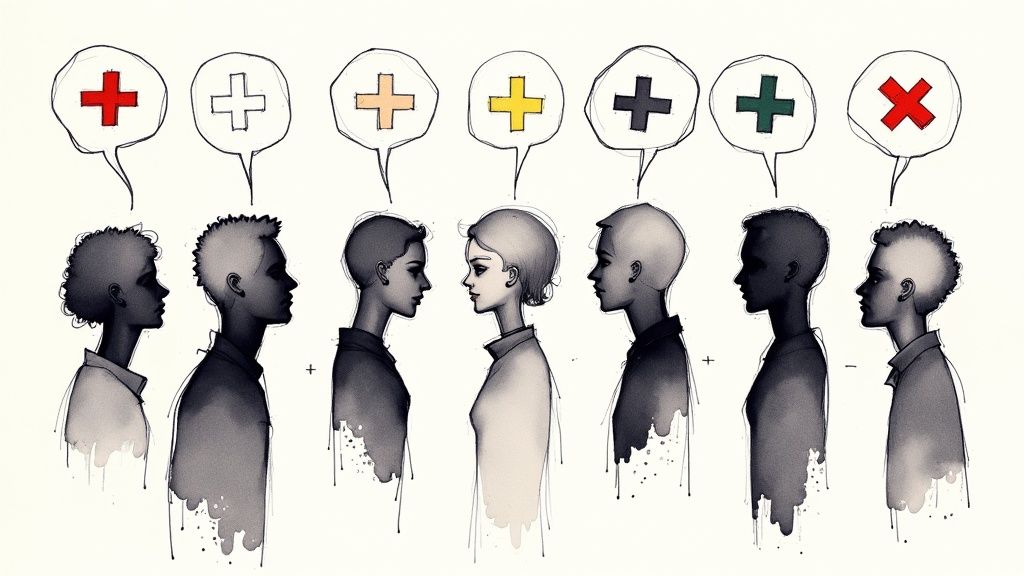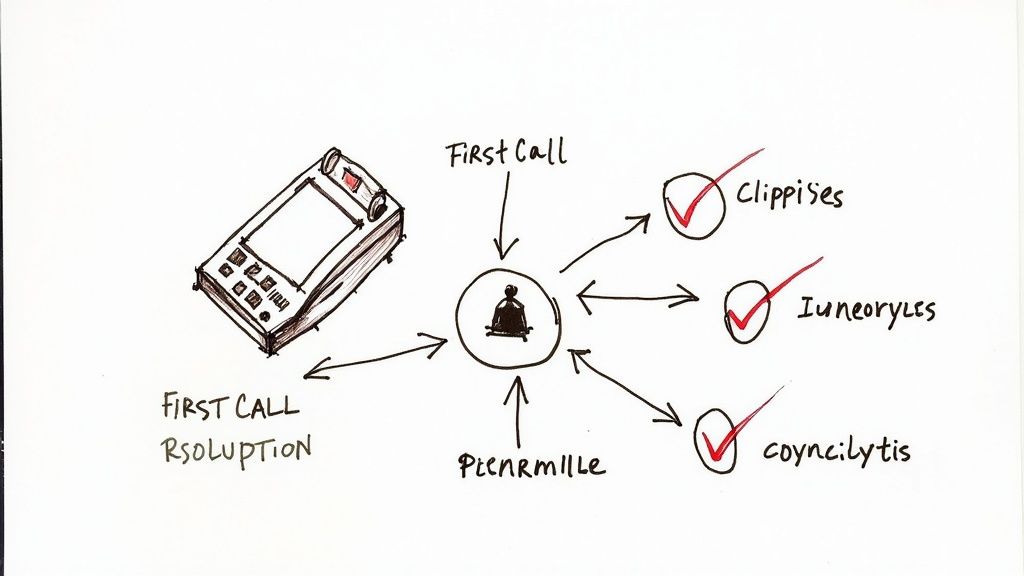15 Essential Support KPIs for Business Success
Building Your Customer Service Metrics Foundation

Measuring and tracking the right customer service metrics helps you understand how well you're serving customers and where you can improve. Clear data about your team's performance shows you what's working and what needs attention. Let's look at some key metrics that can help strengthen your customer service strategy and how to put them to work effectively.
Essential Customer Service Metrics Examples
The Customer Satisfaction Score (CSAT) is one of the most basic but important metrics to track. It measures how happy customers are after interacting with your support team, buying a product, or using your service. Teams usually collect CSAT data through quick surveys right after helping a customer - for example, asking them to rate their experience from 1-5 stars. By analyzing these scores over time, you can spot trouble areas and make focused improvements.
First Response Time (FRT) is another critical metric showing how quickly your team gets back to customers who need help. Speed matters - research shows 72% of customers expect a response within 30 minutes. To improve FRT, companies often streamline their support processes, add chatbots for instant answers, or adjust staffing to cover busy periods. Getting back to customers faster tends to make them happier with the service overall.
The Customer Effort Score (CES) measures how much work customers have to do to get their problems solved. A high score means they're running into friction points, like a confusing returns process or hard-to-navigate help section. Making things easier for customers can boost their loyalty and make them more likely to stick around.
Leveraging Metrics for Actionable Insights
These metrics work together to paint a complete picture of your customer service quality. For example, if it takes too long to respond to customers, both their satisfaction and effort scores will likely suffer. Understanding these connections helps you take a well-rounded approach to measuring and improving service.
Turning Data into Improvement
The real value comes from carefully studying the data to find patterns. You might look at scores across different customer groups, product lines, or support channels. This helps uncover common issues and their root causes. Based on what you learn, you can make smart changes - whether that's giving your support team more training, fixing broken processes, or adding new tools to help customers. The goal is to use these metrics to drive real improvements that make customers' lives easier.
Mastering Net Promoter Score for Growth

While Customer Satisfaction Score (CSAT) helps measure immediate customer reactions, Net Promoter Score (NPS) reveals deeper insights about long-term customer loyalty and business growth potential. This key metric focuses on how likely customers are to recommend your business to others, giving you a clear picture of overall customer sentiment.
Understanding the NPS Framework
At its core, NPS relies on one simple but powerful question: "On a scale of 0 to 10, how likely are you to recommend [your company] to a friend or colleague?" Based on their answers, customers fall into three groups:
-
Promoters (9-10): Your biggest fans who actively recommend your brand to others. These loyal customers make repeat purchases and bring in new business through word-of-mouth.
-
Passives (7-8): Satisfied customers who could easily switch to competitors. With the right engagement, you can turn these customers into active promoters.
-
Detractors (0-6): Unhappy customers who might discourage others from using your services. Understanding and addressing their concerns helps prevent negative word-of-mouth.
To calculate your NPS, subtract the percentage of detractors from the percentage of promoters. A negative score means you have more detractors than promoters - a red flag for customer experience issues.
Why NPS Matters for Business Growth
NPS directly connects to business performance. Companies that regularly track and improve their NPS often see faster growth compared to competitors. Studies show businesses with high NPS scores typically enjoy better customer retention and higher customer lifetime value. This makes sense - happy customers stick around longer and bring in new business through recommendations. For instance, many companies have seen significant increases in referrals after implementing NPS tracking.
Turning NPS Insights into Action
The real value of NPS comes from acting on the feedback. Following up with customers after they complete the survey helps uncover the "why" behind their scores. This insight drives meaningful improvements.
For example, reaching out to detractors lets you address their specific concerns and potentially win back their loyalty. Talking with promoters reveals what aspects of your service resonate most, helping you double down on your strengths. You might learn that your quick response times or personal touch makes customers especially happy.
Regular NPS tracking also shows how changes in your customer service approach affect satisfaction over time. This data helps guide smart decisions about where to focus improvement efforts. By consistently gathering and acting on NPS feedback, you can build stronger customer relationships that fuel long-term growth.
Response Time Strategies That Win Customer Trust

When it comes to customer service, speed matters. Research shows that 72% of customers expect a response within 30 minutes of reaching out. But there's more to great service than just being quick - the quality of each interaction is equally important. Let's explore how to deliver both fast and meaningful support that builds lasting customer relationships.
Balancing Speed and Quality: A Delicate Dance
Picture this: You send a detailed question about a product issue and receive an instant but generic response that completely misses the point. Not very helpful, right? The key is finding the sweet spot between rapid replies and genuinely solving customer problems. This means training support teams to provide personalized assistance efficiently, using tools and processes that enable both speed and care in every interaction.
Strategies for Optimizing Response Times
Here are practical ways to improve response times while maintaining service quality:
-
Smart Automation: Use Zendesk or similar tools to handle basic questions automatically. This frees up your team to focus on more complex customer needs that require a human touch.
-
Channel-Specific Approaches: Different support channels need different response strategies. Live chat requires near-instant replies, while email allows more time for detailed answers. Set clear expectations for each channel and staff them accordingly.
-
Team Planning: Schedule your support team based on when customers need help most. Having more people available during busy periods means faster response times when they matter most.
-
Easy Access to Information: Build a searchable help center where both customers and support agents can quickly find answers. This speeds up resolution times and helps customers solve simple issues on their own.
Setting Realistic Goals and Tracking Performance
Start by setting clear response time targets that make sense for your business. For instance, you might aim to answer live chat messages within one minute while giving email responses a four-hour window. Make these goals specific and measurable.
Track key metrics like First Response Time (FRT) to see how you're doing and spot areas that need work. But don't look at speed alone - measure customer satisfaction scores and resolution rates too. This gives you the full picture of how your support team is performing. By regularly reviewing these numbers and adjusting your approach, you can build a support system that consistently delivers fast, helpful service that keeps customers coming back.
Converting Customer Effort to Loyalty

While many companies track metrics like First Response Time and Net Promoter Score, Customer Effort Score (CES) stands out by measuring how much work customers need to put in to get help. This metric gives clear insights into whether your support experience feels effortless or frustrating for customers. Research shows that high effort directly leads to customers switching to competitors. Let's explore why CES matters and how to use it effectively.
Why Measuring Customer Effort Matters
Think about your own experiences as a customer - when something is difficult or takes too much time, you're less likely to stick with that company. The same applies to your customers. Making interactions simple and smooth builds loyalty naturally. For instance, offering easy returns or clear self-help resources removes friction points that might otherwise drive customers away. This focus on reducing effort is especially important since finding new customers typically costs five times more than keeping existing ones happy.
Customer Service Metrics Examples: Measuring and Interpreting CES
Most companies measure CES through a simple survey asking "How much effort did you personally have to put forth to handle your request?" Customers rate their experience on a 1-5 scale from very low to very high effort. Some businesses prefer a seven-point scale asking if "The company made it easy for me to handle my issue."
The real value comes from analyzing patterns in your CES data. A rising average score signals growing friction in the customer experience. Breaking down scores by customer groups, products, or support channels helps pinpoint exactly where customers struggle most.
Identifying and Eliminating Friction Points
After gathering CES data, look for common sources of customer frustration:
- Complex Navigation: Confusing websites and help centers that make information hard to find
- Repetitive Information Requests: Making customers repeat themselves to multiple support agents
- Lengthy Resolution Times: Slow responses and drawn-out problem-solving processes
- Lack of Self-Service Options: Forcing customers to contact support for basic questions
Practical Techniques for Reducing Customer Effort
Address these friction points through focused improvements:
- Streamlined Processes: Make common transactions like returns quick and clear
- Proactive Communication: Keep customers updated without them having to ask
- Empowered Support Agents: Give agents the tools and information to solve issues on first contact
- Robust Self-Service Options: Build a thorough knowledge base and add AI chatbots like Sitebot to handle basic questions, freeing up agents for complex issues
By regularly checking CES and fixing pain points, you can create experiences that feel effortless to customers. This steady focus on making things easier builds the kind of lasting relationships that help businesses grow sustainably through strong customer loyalty.
Using AI for Next-Generation Service Metrics
As more customer interactions move online, businesses have new opportunities to improve service using Artificial Intelligence. AI helps companies analyze customer behavior patterns and interactions at scale, enabling them to go beyond basic metrics and take a more data-driven approach to delivering great service.
Predictive Analytics and Proactive Service
One key advantage of AI in customer service is its ability to spot patterns and predict what customers might need next. By analyzing customer interactions, purchase history, and online behavior, AI systems can identify potential issues before they become problems. For instance, if AI notices a customer repeatedly visiting help articles about a specific feature, it can trigger proactive support outreach. This shifts companies from just reacting to problems to preventing them entirely.
AI-Powered Chatbots and Automated Solutions
AI chatbots have become invaluable for handling routine customer questions around the clock. Modern chatbots can understand natural conversations and provide helpful, personalized responses. They learn from each interaction to continuously improve their answers. This automation lets human agents focus on complex issues that need a personal touch. For example, Sitebot makes it simple to set up AI chatbots customized for specific business needs.
Measuring AI-Driven Service Success
Adding AI to customer service requires tracking new types of metrics. While traditional measures like customer satisfaction scores still matter, companies need additional ways to assess automated support. Key metrics include how often chatbots successfully resolve issues, how long conversations take, and analysis of customer sentiment during interactions. It's also important to measure the impact on human agents - are they able to handle more complex cases now? Do they feel more satisfied focusing on challenging work?
Balancing Automation and the Human Touch
The most effective AI implementations carefully balance automation with human interaction. While AI excels at handling repetitive tasks and data analysis, human agents bring critical skills like empathy and creative problem-solving. Companies need clear strategies for blending AI and human support in ways that enhance the overall experience. This means using automation for routine queries while empowering agents to build genuine connections with customers on more complex issues. When implemented thoughtfully, AI and human agents work together to deliver consistently excellent service.
Creating Your Metrics Success Roadmap
Building a successful customer service metrics program requires careful planning and clear direction, much like constructing a house. Just as you need a solid blueprint and the right tools to build a stable structure, creating a measurement strategy demands thoughtful preparation to drive continuous service improvement.
Choosing the Right Metrics Mix
Just as doctors rely on multiple tests for accurate diagnosis, tracking customer service performance requires combining different metrics to paint a complete picture. For instance, pairing Customer Satisfaction (CSAT) scores with First Response Time (FRT) and Customer Effort Score (CES) helps reveal crucial insights. As a result, you might discover that while customers are satisfied with resolutions (high CSAT), they find the process difficult (high CES). This insight points directly to opportunities for simplifying your service processes to build customer loyalty.
Tools and Technologies for Streamlined Measurement
Zendesk and similar customer service platforms provide built-in analytics tools that make tracking key metrics straightforward. These systems automatically gather data and generate reports, freeing up time while offering valuable insights. When connected to your Customer Relationship Management (CRM) system, these tools create a complete view of each customer's journey. This broader perspective often reveals important patterns between service interactions and other touchpoints, helping teams fine-tune the entire customer experience.
Avoiding Implementation Pitfalls
A common mistake is trying to measure everything at once. Instead, focus on a few key metrics that directly connect to your business goals. Another frequent error is collecting data without taking action. Metrics should guide improvements - use them to spot problems and make specific changes to enhance customer experiences. This might mean updating support procedures, offering more staff training, or adding new self-service options. Regular monitoring and adjustment keep improvements on track.
Building a Sustainable Improvement Cycle
Converting metrics into real business value takes a systematic approach. Begin with clear objectives, then set up regular reporting and review sessions. Examine the data to spot trends, identify root causes, and develop targeted fixes. For example, if you notice consistently slow first response times, investigate why - is it due to staff shortages, complicated processes, or other factors? Once you find the source of the problem, you can take specific steps like adjusting schedules or simplifying workflows. Keep tracking these changes to ensure they're having the intended effect. This creates an ongoing cycle of improvement driven by data and focused on making customers' lives easier.
Boost your customer service with Sitebot's AI-powered chatbots. Automate support, improve response times, and create effortless customer experiences. Get started today: https://sitebot.co


